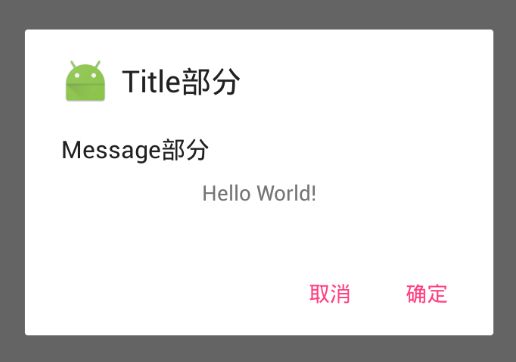转载请注明文章出处LooperJing!
上一篇分析了一下Activity的Window创建过程和Window与Activity是如何关联到一起的,通过上一篇,我们对Window有了基本的认识。这一篇分享一下我对Dialog加载绘制流程的理解。
首先创建一个Dialog,回顾下创建Dialog的流程。
public class MainActivity extends Activity {
AlertDialog alertDialog=null;
@Override
protected void onCreate(Bundle savedInstanceState) {
super.onCreate(savedInstanceState);
setContentView(R.layout.activity_main);
AlertDialog.Builder builder = new AlertDialog.Builder(MainActivity.this);
builder.setIcon(R.mipmap.ic_launcher);
builder.setMessage("Message部分");
builder.setTitle("Title部分");
builder.setView(R.layout.activity_main);
builder.setPositiveButton("确定", new DialogInterface.OnClickListener() {
@Override
public void onClick(DialogInterface dialog, int which) {
alertDialog.dismiss();
}
});
builder.setNegativeButton("取消", new DialogInterface.OnClickListener() {
@Override
public void onClick(DialogInterface dialog, int which) {
alertDialog.dismiss();
}
});
alertDialog = builder.create();
alertDialog.show();
}
}
运行效果如下,截图中hello world是main布局里面的。
我们看一下Dialog的部分代码
public class AlertDialog extends AppCompatDialog implements DialogInterface {
final AlertController mAlert;
static final int LAYOUT_HINT_NONE = 0;
static final int LAYOUT_HINT_SIDE = 1;
protected AlertDialog(@NonNull Context context) {
this(context, 0);
}
/**
*构造函数,可以指定主题,比如 R.attr#alertDialogTheme
*/
protected AlertDialog(@NonNull Context context, @StyleRes int themeResId) {
super(context, resolveDialogTheme(context, themeResId));
mAlert = new AlertController(getContext(), this, getWindow());
}
/**
*构造函数,点击外部是否可取消,取消时候的回调
*/
protected AlertDialog(@NonNull Context context, boolean cancelable,
@Nullable OnCancelListener cancelListener) {
this(context, 0);
setCancelable(cancelable);
setOnCancelListener(cancelListener);
}
/**
获取对话框中的按钮,比如可以获取BUTTON_POSITIVE
*/
public Button getButton(int whichButton) {
return mAlert.getButton(whichButton);
}
//设置标题,内部调用了 mAlert.setTitle(title)
@Override
public void setTitle(CharSequence title) {
super.setTitle(title);
mAlert.setTitle(title);
}
/**
* 标题也可能是一个View,此时设置标题用这个方法
*/
public void setCustomTitle(View customTitleView) {
mAlert.setCustomTitle(customTitleView);
}
public void setMessage(CharSequence message) {
mAlert.setMessage(message);
}
.......
public static class Builder {
private final AlertController.AlertParams P;
private final int mTheme;
//构造函数
public Builder(@NonNull Context context) {
this(context, resolveDialogTheme(context, 0));
}
//构造函数
public Builder(@NonNull Context context, @StyleRes int themeResId) {
P = new AlertController.AlertParams(new ContextThemeWrapper(
context, resolveDialogTheme(context, themeResId)));
mTheme = themeResId;
}
@NonNull
public Context getContext() {
return P.mContext;
}
public Builder setTitle(@StringRes int titleId) {
P.mTitle = P.mContext.getText(titleId);
return this;
}
public Builder setTitle(CharSequence title) {
P.mTitle = title;
return this;
}
public Builder setCustomTitle(View customTitleView) {
P.mCustomTitleView = customTitleView;
return this;
}
public Builder setMessage(@StringRes int messageId) {
P.mMessage = P.mContext.getText(messageId);
return this;
}
public Builder setMessage(CharSequence message) {
P.mMessage = message;
return this;
}
.......
public AlertDialog create() {
final AlertDialog dialog = new AlertDialog(P.mContext, mTheme);
//Dialog的参数其实保存在P这个类里面
P.apply(dialog.mAlert);
dialog.setCancelable(P.mCancelable);
if (P.mCancelable) {
dialog.setCanceledOnTouchOutside(true);
}
dialog.setOnCancelListener(P.mOnCancelListener);
dialog.setOnDismissListener(P.mOnDismissListener);
if (P.mOnKeyListener != null) {
dialog.setOnKeyListener(P.mOnKeyListener);
}
return dialog;
}
public AlertDialog show() {
final AlertDialog dialog = create();
dialog.show();
return dialog;
}
}
}
从代码中可以看到,我们创建的Dialog是什么样式,可以通过Builder的set系列方法指定,是当我们调用Builder的set系列方法的时候,会将我们传递的参数保存在P中,这个P是什么呢?在Builder有一个成员
private final AlertController.AlertParams P;
P是AlertController的内部类AlertParams类型的变量。AlertParams中包含了与AlertDialog视图中对应的成员变量。调用Builder的set系列方法之后,我们传递的参数就保存在P中了。P存在之后,我们就可以创建对话框了。这个就好像,我们要建造房子,得先有设计图纸,图纸决定了房子的样子。
public AlertDialog create() {
final AlertDialog dialog = new AlertDialog(P.mContext, mTheme);
P.apply(dialog.mAlert);
}
用new的方式创建一个AlertDialog,AlertDialog的构造函数中调用了super,AlertDialog继承Dialog,看一下Dialog的构造函数。
Dialog(@NonNull Context context, @StyleRes int themeResId, boolean createContextThemeWrapper) {
....
mWindowManager = (WindowManager) context.getSystemService(Context.WINDOW_SERVICE);
final Window w = new PhoneWindow(mContext);
mWindow = w;
w.setCallback(this);
w.setOnWindowDismissedCallback(this);
w.setWindowManager(mWindowManager, null, null);
w.setGravity(Gravity.CENTER);
mListenersHandler = new ListenersHandler(this);
}
可以发现直接new了一个PhoneWindow赋值给mWindow,并且设置了callback回调,当窗口状态发生变化的时候,就会回调Dialog中的callback实现。这个和Activity的一模一样,之前已经分析过了。当你new AlertDialog()之后,到此,Dialog所需要的Window就有了。接下来,就要分析,Dialogd的视图怎么与Window做关联了,继续往下面走。
在AlertDialog创建之后,就调用 P.apply(dialog.mAlert),将P中的参数赋值给dialog的mAlert,mAlert是AlertController类型。我们看一下apply函数。
public void apply(AlertController dialog) {
if (mCustomTitleView != null) {
dialog.setCustomTitle(mCustomTitleView);
} else {
if (mTitle != null) {
dialog.setTitle(mTitle);
}
if (mIcon != null) {
dialog.setIcon(mIcon);
}
if (mIconId != 0) {
dialog.setIcon(mIconId);
}
if (mIconAttrId != 0) {
dialog.setIcon(dialog.getIconAttributeResId(mIconAttrId));
}
}
if (mMessage != null) {
dialog.setMessage(mMessage);
}
if (mPositiveButtonText != null) {
dialog.setButton(DialogInterface.BUTTON_POSITIVE, mPositiveButtonText,
mPositiveButtonListener, null);
}
if (mNegativeButtonText != null) {
dialog.setButton(DialogInterface.BUTTON_NEGATIVE, mNegativeButtonText,
mNegativeButtonListener, null);
}
if (mNeutralButtonText != null) {
dialog.setButton(DialogInterface.BUTTON_NEUTRAL, mNeutralButtonText,
mNeutralButtonListener, null);
}
if ((mItems != null) || (mCursor != null) || (mAdapter != null)) {
createListView(dialog);
}
if (mView != null) {
if (mViewSpacingSpecified) {
dialog.setView(mView, mViewSpacingLeft, mViewSpacingTop, mViewSpacingRight,
mViewSpacingBottom);
} else {
dialog.setView(mView);
}
} else if (mViewLayoutResId != 0) {
dialog.setView(mViewLayoutResId);
}
}
代码很简单,就纯粹做一件事,把P中的参数赋值给dialog的mAlert中对应的参数,比如标题,按钮等等。这些都没有什么,下面干货来了。继续看Dialog的show方法,记住,我们现在的任务是,分析Dialog视图是怎么与Window做关联的!。
public void show() {
if (mShowing) {
if (mDecor != null) {
if (mWindow.hasFeature(Window.FEATURE_ACTION_BAR)) {
mWindow.invalidatePanelMenu(Window.FEATURE_ACTION_BAR);
}
mDecor.setVisibility(View.VISIBLE);
}
return;
}
mCanceled = false;
if (!mCreated) {
dispatchOnCreate(null);
}
onStart();
mDecor = mWindow.getDecorView();
if (mActionBar == null && mWindow.hasFeature(Window.FEATURE_ACTION_BAR)) {
final ApplicationInfo info = mContext.getApplicationInfo();
mWindow.setDefaultIcon(info.icon);
mWindow.setDefaultLogo(info.logo);
mActionBar = new WindowDecorActionBar(this);
}
WindowManager.LayoutParams l = mWindow.getAttributes();
if ((l.softInputMode
& WindowManager.LayoutParams.SOFT_INPUT_IS_FORWARD_NAVIGATION) == 0) {
WindowManager.LayoutParams nl = new WindowManager.LayoutParams();
nl.copyFrom(l);
nl.softInputMode |=
WindowManager.LayoutParams.SOFT_INPUT_IS_FORWARD_NAVIGATION;
l = nl;
}
mWindowManager.addView(mDecor, l);
mShowing = true;
sendShowMessage();
}
看下面,当mCreated为假的时候,调用dispatchOnCreate,最终是回调了Dialog的onCreate方法。
if (!mCreated) {
dispatchOnCreate(null);
}
void dispatchOnCreate(Bundle savedInstanceState) {
if (!mCreated) {
onCreate(savedInstanceState);
mCreated = true;
}
}
protected void onCreate(Bundle savedInstanceState) {
}
Dialog里面的onCreate是个空实现,我们要看看AlertDialog的onCreate方法的里面的东西。
@Override
protected void onCreate(Bundle savedInstanceState) {
super.onCreate(savedInstanceState);
mAlert.installContent();
}
调用 mAlert.installContent()方法,上面说了mAlert是AlertController类型,AlertController中有Dialog所需要的样式参数。
public void installContent() {
final int contentView = selectContentView();
mDialog.setContentView(contentView);
setupView();
}
有木有!!!终于发现了setContentView方法,先通过selectContentView布局文件的ID,然后调用Window的setContentView方法,加载指定的文件到DecorView的Content部分,并且回调onContentChanged方法通知Dialog。
@Override
public void setContentView(int resId) {
ensureSubDecor();
ViewGroup contentParent = (ViewGroup) mSubDecor.findViewById(android.R.id.content);
contentParent.removeAllViews();
LayoutInflater.from(mContext).inflate(resId, contentParent);
mOriginalWindowCallback.onContentChanged();
}
setContentView执行之后,调用了setupView方法和setupDector方法,这两个方法的主要作用就是初始化布局文件中的组件和Window对象中的mDector成员变量。现在回到我们的show方法,在执行了dispatchOnCreate方法之后我们又调用了onStart方法。在看show方法里面,会调用下面三行代码。
mDecor = mWindow.getDecorView();
WindowManager.LayoutParams l = mWindow.getAttributes();
mWindowManager.addView(mDecor, l);
最终会通过WindowManager将DecorView添加到Window之中,OK到这里整个Dialog的界面就会被绘制出来了。
总结一下:AlertDialog和Activity一样,内部有一个Window,我们构造AlertDialog.Builder,通过Builder设置Dialog各种属性,,这些参数会被放在一个名为P(AlertController类型)的变量中,在调用AlertDialog.Builder.create方法的时候,内部首先会new一个 AlertDialog,AlertDialog的父类Dialog的构造函数中会new一个PhoneWindow赋值给AlertDialog中的Window,并且为它设置了回调。AlertDialog创建之后执行apply方法,将P中的参数设置赋值给Dialog,后我们调用Dialog.show方法展示窗口,内部调用dispatchOnCreate,最终会走到setContentView,到此Dialog的Window和Dialog视图关联到了一起,最后执行mWindowManager.addView方法,通过WindowManager将DecorView添加到Window之中,此时Dialog显示在了我们面前。
Please accept mybest wishes for your happiness and success!
